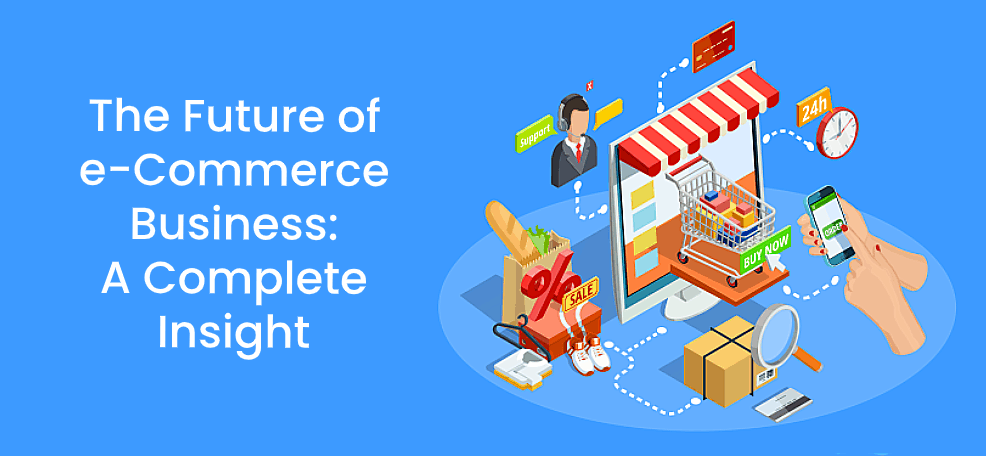E-commerce, e-commerce, online or online commerce: all these terms refer to purchasing and selling goods or services using electronic information technologies. The Internet is the primary technology.
But other digital data transmission and processing forms, such as mobile telephony, electronic customer databases, or accounting software, are also used in this field.
Digital marketing agency or Advertising agencies leads us to ask ourselves how far the power of electronic commerce extends and especially what electronic commerce is, what are its advantages and disadvantages and what are its current trends.
What is electronic commerce?
In addition to the purchasing processes themselves, e-commerce includes all the processes that enable you to initiate and process a purchase. An online shop functions as a central sales platform on which potential buyers can not only browse the product range but also order and pay via a dedicated digital system. An electronic merchandise management system records the product sold and updates the stock. An RFID chip follows the shipping route. Finally, CRM systems allow you to manage your customer relationship well.
In a narrower definition, e-commerce is, therefore, part of e-business. This includes all automated business processes using electronic information and communication technologies. Using these highly automated business processes is to make work more efficient and increases turnover.
Digital technologies form the basis of eCommerce development. Different technologies can then be involved: the spectrum ranges from simple radio technology (e. g. Bluetooth) to very complex systems based on artificial intelligence (AI). In addition to communication technologies via the Internet and telephony, electronic databases, word processing software, social media or television are also used as advertising channels, payment transactions via online banking, and chat-bots for customer service.
Features of e-commerce
For companies, the goal of e-commerce is to optimize sales processes in order to generate more revenue. The aim is to make all sales operations more efficient and reduce associated costs. Companies have gained new sales channels via the Internet through online shops, product reviews, marketplaces (e. g. Amazon) or building an auction website (e. g. eBay). Thanks to social media, web advertising, newsletters and automated CRM systems, merchants can win new customers and improve their relationships with them with relatively little effort.
E-commerce aims to increase its efficiency. For example, it speeds up the sales process. Customers can easily browse the range from their smartphone or personal computer and order at any time. Computer-aided systems automate processes and thus save time. At the same time, personnel costs are also reduced.
E-commerce allows any type of commercial transaction. The latter can be processed both in B2C (trade between companies and consumers) and also in B2B (trade between companies).
Advantages of electronic commerce
Companies can benefit from e-commerce in several ways. Here are some of its great advantages:
- Overcoming distances: the Internet makes it possible to avoid merchants being dependent on a fixed point of sale. They can enter new sales markets across regions around the world. Although the distribution of material goods continues to require the expansion of logistics capacity, there is no need to open new sites. The communication facilities offered by the Internet often reduce some business travel needs. From the consumer’s point of view, the advantage of e-commerce is that they can choose from a wide range of products and compare quality and prices directly.
- Faster purchasing processes: e-commerce makes it possible to make purchases without delay. Buyers no longer need to go to the store to buy their products. Instead, they can place orders 24 hours a day from home or from any computer or mobile. An automated order confirmation is immediately sent by dedicated systems. On the sales side, it is very easy to offer and manage your services online. For example, a travel agency can easily advise people interested in a destination and process bookings.
- Reduced transaction costs through e-commerce: e-commerce can potentially avoid the need to rent new shops and warehouses. Inventory, cash register and other systems designed specifically for online store management automatically track inventory and cash flows.
- Omnichannel and multichannel marketing: if the situation allows, it is worthwhile to have an online and offline presence using all the channels at your disposal. If you use an online store, social media, and your own business, then consumers have more contact points to turn to access your offer.
- Extensive advertising: Social media, blogs, and corporate websites offer inexpensive ways to draw attention to offers. Companies are active on Facebook benefit in particular from the wide reach of this network. SEO marketing and advertising agencies in dubai can be effectively developed with an advertising budget that is often much lower than traditional advertisements, such as those printed in magazines or broadcast on television. In addition, online advertising is easier to customize than traditional advertising.
- Opportunities to be closer to the customer: Social media allows you to establish more personal contact with potential customers and improve your company’s image. Monitoring and analysis tools facilitate the collection of personal data and the creation of accurate customer profiles. This makes it easier to plan advertising campaigns and adapt the product range to demand. CRM systems make it easier for you to stay in touch with your customers.
- More satisfied customers: email customer services, online contact forms or instant messaging can overcome the shyness of some to seek advice. Thanks to these technologies, customers can ask questions 24 hours a day and receive a quick response. Simplifying the processes for placing and paying for an order significantly reduces the efforts of both customers and companies.
The disadvantages of electronic commerce
E-commerce can also have some disadvantages for companies and customers. This depends largely on the industry in which you operate and the capacities at your disposal.
- Complex implementation: Building a digital infrastructure requires time and money. Not all small retailers have the know-how or the human and financial skills to set up an online store or manage their social media on a regular basis.
- Expertise and work on advertising: to assess how much you can save costs, it is necessary to take into account the industry in which you work. In highly competitive markets, companies have to fight tooth and nail to draw attention to the World Wide Web. A simple Google AdWords advertising campaign is not enough. In addition, with smartphones and social media, users’ attention time has become shorter. As for search engine marketing (SEO), it requires know-how or sometimes the more expensive support of a specialized agency.
- Increased competition and price pressure: Global online commerce has led to an exponential increase in the number of competitors. If supply exceeds demand, there is enormous pressure on companies in their pricing strategies.
- Lack of personalized advice: Not all online retailers can offer 24-hour customer service or have the resources to integrate chatbots into their websites. Unlike the traditional physics shop, the customer will not have any direct contact for advice.
- Damaging own shops: the booming Internet trade is taking place at the expense of in-store retailers. New strategies must be developed by physical shops, which are seeing the number of their visitors decrease. We are thinking in particular of bookstores, which are suffering drastically from the success of the giant Amazon.
- Payment security and data protection: some Internet users continue to avoid online shopping for security reasons or because they do not want to provide their personal data.
Current trends in Internet commerce
Due to new developments in the future, e-commerce continues to grow.
Online shopping is by no means limited to the younger generation. Age differences play an increasingly less important role: many people over 65 are now comfortable with the Internet. Companies that strongly target digital natives in their marketing can thus miss out on other potential customers. However, purchasing behavior differs widely between these groups. For clothes and shoes, the elderly still prefer physics shops. On the other hand, young people aged 14 to 29 go online much more often, regardless of the merchandise.
A major challenge for online commerce is now to personalize the online shopping experience. The trend is therefore towards individualized offers and using dynamic creative to personalize your ads. Many users appreciate, for example, the ability to purchase a gift voucher that is tailor-made for them or to book a trip at very special conditions. Loyal customers expect discounts, personalized attention, and appropriate purchase recommendations. Analysis and monitoring tools such as Google Analytics allow the collection of personal data to make this work easier. They record the buying and browsing behavior of users in order to adjust the settings for their next visit to the online store. Internet merchants can then better know their customers’ product preferences and understand what they are willing to pay.
Many experiments are also being conducted in the field of virtual reality. This technology allows users to fully immerse themselves in the world of products. The immersive showroom of the Swedish group IKEA is a good example. It allows customers who are still undecided to virtually assemble their furniture, to choose the most appropriate colors and even to visualize their choices at different times of the day (thanks to a change in brightness).
Online purchases are increasingly being made from mobile devices. In a few years, mobile phone purchases have exploded. To follow the trend, it is therefore important to design a responsive website, i.e. one that can be adapted to different output formats. This simplifies navigation on the small screen of mobile devices and shortens loading times. Le Figaro thus indicates that one out of five online purchases would be made on mobile phones.
Poor network connections are still a barrier for consumers who want to buy on their mobile phones. But with the new 5G mobile communications standard, this obstacle should be removed. Advertising that reaches consumers 24 hours a day on their mobile phones is also becoming increasingly profitable, with geolocation data that improves targeting. This allows companies to submit offers based on where the consumer is or to attract customers to the nearest store.
Despite these developments, physical commerce has not yet had its last word. On the contrary, customers want the ability to switch from online to offline mode as often as they like. Omnichannel marketing is therefore on the agenda. Even pure players like Zalando are increasingly selling their fashion items in points of sale or outlets; others even offer the possibility of accessing their showrooms. With the “click & collect” service, customers can test a product and collect goods ordered on the Internet themselves to avoid shipping costs. On the other hand, physical stores increasingly offer the possibility to get advice on the Internet (via Skype for example) and to order products there.
By using as many channels as possible, you will inevitably reach more potential buyers but will also most certainly increase customer satisfaction. For an easier and easier transition between online and offline, you can rely on the innovations of the Internet of Things. For example, thanks to beacons, which are based on Bluetooth technologies, smartphones can receive signals from product shelves or from a specific product in a store. An application records these signals and then provides the customer with detailed information about the products in question. She may also try to draw her attention to promotions or refer her to products that meet her preferences (for example, organic food).
The Internet of Things (IoT) promises to open up entirely new opportunities for e-commerce. The number of everyday objects permanently connected to the Internet and intelligent household appliances are already increased significantly. For example, an intelligent refrigerator can use sensors to indicate when certain foods are almost exhausted and can control them independently. IoT devices allow maximum personalization of advertising and online purchases. Studies also seem to show that smart applications for the home are increasingly popular.
For warehouse management, which is part of the online start, work processes can be facilitated by the use of goods equipped with sensors and connected to the Internet. This makes it possible to check the availability of items in real-time, to avoid, for example, selling products that are out of stock.
There is, therefore, no doubt that e-commerce will continue to grow in importance, particularly as a result of future progress and innovation.




